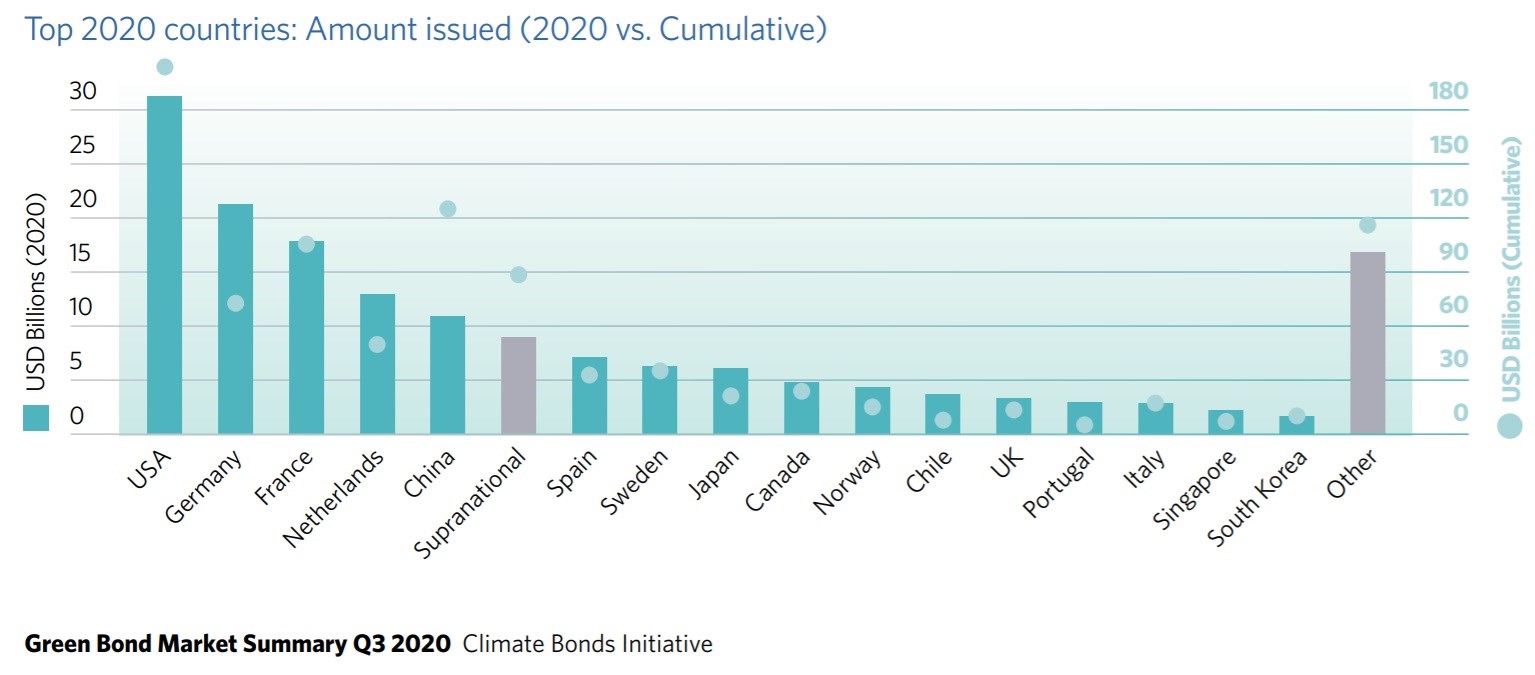
Green bonds were created to fund projects that have positive environmental and/or climate benefits. The green bond market kicked off in 2007 with the AAA-rated issuance from multilateral institutions, the European Investment Bank (EIB) and World Bank.
Initially these bonds were mainly issued by supranational financial institutions, then first green muni bond was issued by Massachusetts in June 2013 and in November 2014 there was a turning point in the market as the first corporate green bond issued by Vasakronan, a Swedish property company.
The Road from Paris
It’s been five years since the Paris Agreement, when 196 countries committed themselves to a global framework to tackle climate change. These nations pledged to limit global warming to well below 2°C and to pursue efforts to limit it to 1.5°C. But half a decade on, the gap between commitment and real effort remains apparent.
According to the latest report by the UN Environment Programme (UNEP), between 2020 and 2030 global coal, oil, and gas production would have to decline annually by 11%, 4%, and 3% respectively to be consistent with a 1.5°C pathway. Yet government plans and projections indicate an average 2% annual increase for each of these fuels. While the Covid-19 pandemic and the lockdown measures led to short-term drops in coal, oil, and gas production, pre-Covid plans and post-Covid stimulus measures point to a continuation of the growing global fossil fuel production gap, risking severe climate disruption.
How can investors help? While the environmental challenges remain complex, good news comes from the fact that investors have shifted gears on the issue. According to the Climate Bond Initiative, by the end of October 2020, the yearly global green bond and loans market has reached $194.6 billion, with $46.4 billion (24%) of that bond issuance certified under the Climate Bonds Standard - a 9% increase from a year ago.
Prominent bonds issued this year which were certified include sovereign green bonds issued by Chile and the Netherlands, major Chinese banks, car manufacturer Volkswagen and Japanese fast train network operator JRTT. Overall, certified green bonds and loans have now been issued by more than 160 organisations from 36 nations, influencing the green market’s directions toward best practice in both developed and emerging economies. The Climate Bond Initiative estimates that labelled green bond issuances should reached $350 billion in 2020, up from $265 billion issued in 2019.
The country rankings for 2020 to the end of Q3 are led by USA (with $32.3 billion of green bonds issued), Germany ($21.4 billion) and France ($17.8 billion). While Chinese issuance ($9 billion) still has a way to go to meet its total for 2019 ($31.4 billion), it remains the country with the second largest cumulative total ($105 billion) after the USA ($205 billion).

President Biden Could be a Gamechanger
Currently the green bond market is dominated by euro-denominated bonds, but this could change under US President Biden. “Biden’s commitment to rejoining the Paris agreement when he is inaugurated symbolises a broader transformative shift in climate policy”, said Bram Bos, lead porfolio manager at NN Investment Partners. “The Biden administration will invest heavily in sustainable infrastructure and clean energy, which could lead to an inaugural green US Treasury issue and further boost the global green bond market.”
Bos thinks Biden’s climate and environmental justice proposal equates to federal investment of $1.7 trillion over the next decade with additional private sector, state and local investments set to take the total to more than $5 trillion.
“The need to fund these investments will be a pivotal opportunity for the US to enter the green bond market as a sovereign issuer”, adds Bos. “This could prompt other governments worldwide to follow, sparking significant growth in the global green bond market.”
What Are the Options for Fund Investors?
European investors can choose from 51 open-end mutual funds and five exchange-traded funds (ETFs) specialising in green bonds (eight of which were launched this year). These products manage at the end of November 2020 a total of €14 billion and attracted €6.4 billion of net inflows in the first eleven months of the year.
The most important in terms of assets is the iShares Green Bond Index fund, which has €2.4 billion in assets. This table shows the the performance of green bond funds available in the UK, ranked according to their Morningstar Sustainability Rating.
Quality not Quantity
Strongly driven by institutional investors, the green bond market is expected to continue growing in the years to come. However, investors should be concerned about the quality of the issues and not invest following catchy marketing campaigns.
Selectivity and transparency do indeed help to ensure that only the most relevant and impactful green projects receive the necessary funding. In this context, it is essential to benefit from in-depth research and knowledge on green bond issuers, as the market is still at the beginning of its development and investors must be alert to the risks of so-called “greenwashing”, where inappropriate projects receive funding after convincing the public of its environmental good faith.
For the green bond market to maintain its pace, actors involved will need to ensure that the associated impacts are well defined, measured and transparent in order to meet the constantly changing expectations of investors.



























